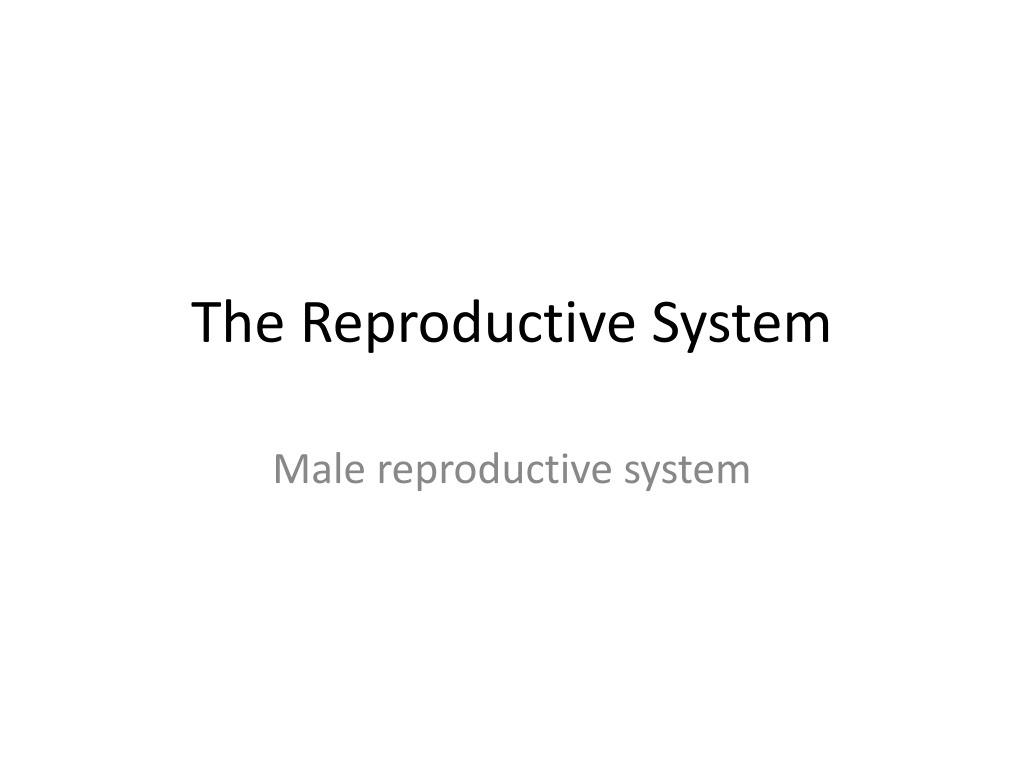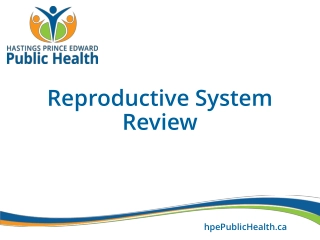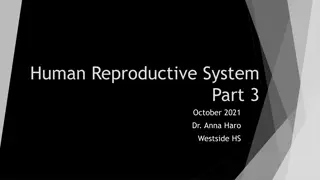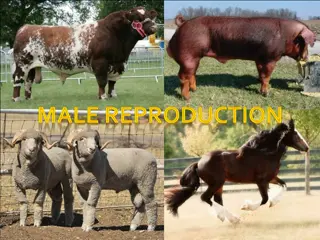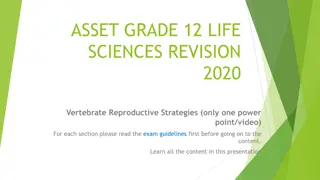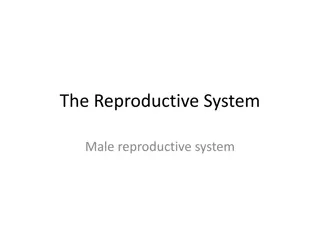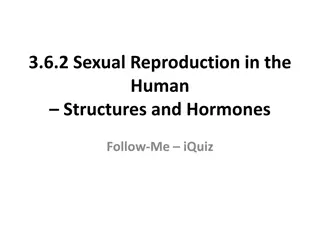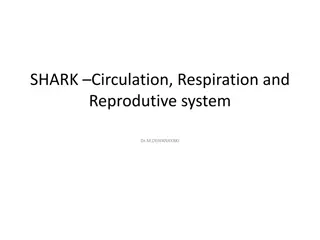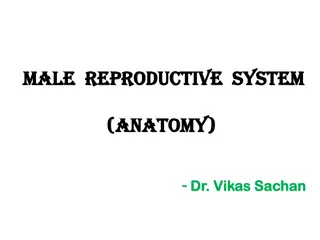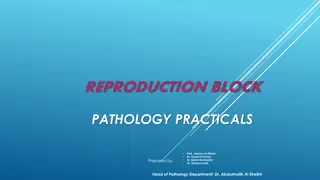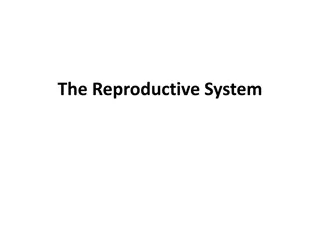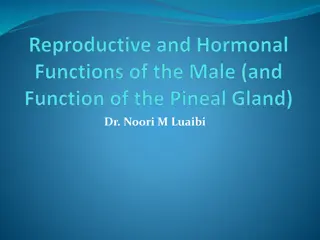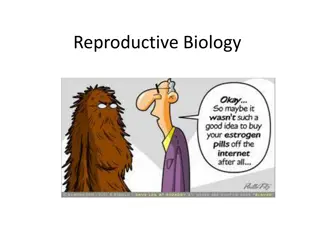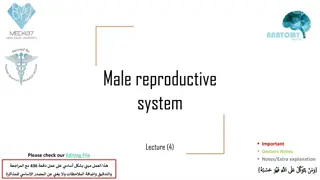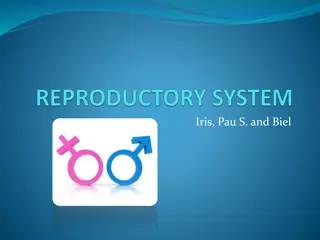Understanding the Male Reproductive System
The male reproductive system is composed of various structures including the testes, ducts, accessory glands, and external genitalia. Sperm production takes place within the testes through a process called spermatogenesis. Hormones such as testosterone play a crucial role in the functioning of this system. The male and female reproductive systems have distinct functions and anatomy. This system's intricate details and processes contribute to human reproduction.
Download Presentation

Please find below an Image/Link to download the presentation.
The content on the website is provided AS IS for your information and personal use only. It may not be sold, licensed, or shared on other websites without obtaining consent from the author. Download presentation by click this link. If you encounter any issues during the download, it is possible that the publisher has removed the file from their server.
E N D
Presentation Transcript
The Reproductive System Male reproductive system
The Reproductive system includes the following: Gonads: or reproductive organs that produce gametes & hormones. Ducts: that receive and transport the gametes. Accessory glands & organs that secrete fluids (into the same glands or other excretory ducts). External genitalia.
The male and female reproductive systems are functionally different: In an adult male, the testes or male gonads secrete sex hormones called androgens (testosterone) & produce billion sperm each day. Mature sperms travel along a lengthy duct system, where they are mixed with secretions of the accessory glands the mixture is known as semen. In an adult female the ovaries or female gonads, typically release: only one immature gamete (called oocyte) per month, this gamete travels along short uterine tubes (oviducts) that end in the muscular uterus. secret hormones Estrogen & Progesterone.
The Male reproductive system: In the testes the sperm cells or spermatozoa, travel within the epididymis the ductus deferens or vas deferens the ejaculatory duct &the urethra. Accessory organs: the seminal vesicles, the prostate gland & the bulbourethral glands secrete into the ejaculatory ducts & urethra. The external genitalia consist of the scrotum (which encloses the testes) & the penis.
Histology of the testes: The testes are subdivided by the septa to series of lobules, and the seminiferous tubules (which are tightly coiled) are distributed among the lobules. Typical testes contain nearly mile of seminiferous tubules & the sperm production occurs within these tubules. Each seminiferous tubule is surrounded by delicate capsule, & loss connective tissue that fills the spaces between the tubules. Within those spaces are numerous blood vessels and large interstitial cells (or Leydig cells), interstitial cells are responsible for the production of androgens (most important is testosterone).
Sperm cells (or spermatozoa) are produced by the Spermatogenesis begins at the outer layer of cells in the seminiferous tubules & proceed towards the lumen. Stem cells called spermatogonia divided by mitosis to produce generations of daughter cells, some of which differentiate into spermatocytes, while meiosis is a specialized form of cell division involved only in the production of gametes (sperms & ovaries). The spermatocytes give rise to the spermatids. At each step in this process, the daughter cells move closer to the lumen of the tubule. The spermatids differentiate into spermatozoa, this differentiation process is called Spermiogenesis & ends as a physically mature spermatozoa & spermoigenesis is the last step in spermatogenesis.
Spermatogenesis involves three integrated processes: 1. Mitosis 2. Meiosis 3. Speriogenesis
1. Mitosis: Is a process that separates the duplicated chromosomes of the original cells into two identical nuclei. The cell division produces daughter cells which are pushed toward the lumen of the tubule. These cells differentiate into spermatocytes that prepare to begin meiosis. Mitosis is a part of the process of somatic cell division, which produces two daughter cells containing 46 chromosomes (23 pairs), called the diploid cells (because the daughter cells contain both members of each chromosome pair).
2. Meiosis: Is a special form of cell division involved in gamete production (the gametes contain half the normal chromosomes), so the fusion of the nuclei of a sperm & an ovum produces a cell that has a normal number of chromosomes (46). In the seminiferous tubules, the meiotic divisions of spermatocytes produce spermatids (undifferentiated male gametes). Meiosis involves two cycles of cell division (meiosis I & II ), and produce four cells, each contain 23 individual chromosomes called haploid cells(because these cells contain only one member of each chromosome). These are the same in the formation of sperm &ova.
3. Spermiogenesis : Spermatids are small & unspecialized cells. In spermiogenesis the spermatids differentiate into a physically mature spermatozoa. (spermiogenesis involves major changes in internal & external structure of the spermatids). Each spermatid matures into a single sperm cell or (spermatozoon). Developing spermatids undergoing spermiogenesis are not free in the seminiferous tubules but they are surrounded by the cytoplasm of the Sustentacular cells. As spermiogenesis proceeds the spermatids develop the appearance of mature spermatozoa, then it loses its attachment to the sustentacular cells & enters the lumen of the seminiferous tubules by Spermation. The process from spermatogonial division to Spermation, takes approximately 9 weeks.
Spermatogenesis & Sustentacular cells: Sustentacular cells play an important role in spermatogenesis, these cells have 6 functions that directly or indirectly affect mitosis, meiosis & spermiogenesis with in the seminiferous tubules:
A- Maintenance of the blood testes barrier. B- Support of mitosis & meiosis. C- Support of spermiogenesis. D- Secretion of inhibin E- Secretion of androgen-binding protein. F- Secretion of Mullerian-inhibiting factor (MIF).
A- Maintenance of the blood testes barrier: The seminiferous tubules are isolated from the general circulation by a blood testes barrier. The sustentacular cells are joined by tight junctions forming a layer that divides the seminiferous tubules into: an outer basal compartment (contains spermatogonia), and an inner luminal compartment (meiosis & spermiogenesis occurs). Transport across the sustentacular cells is tightly regulated so that conditions in the luminal compartment remain very stable, and the fluid within the seminiferous tubules is produced by the sustentacular cells which also regulate the fluids composition(tubular fluid is very different from the surrounding interstitial fluid).
The blood testes barrier is essential for preserving the differences between the tubular fluid & interstitial fluid. Developing spermatozoa contain sperm- specific antigens in their cell membrane & these antigens are not found in the somatic cell membrane, so they would be attacked by the immune system if blood testes barrier did not prevent being detected.
B- Support of mitosis & meiosis: Spermatogenesis depends on the stimulation of sustentacular cells by circulating follicle- stimulating hormone (FSH) & testosterone. Stimulated sustentacular cells will then promote the division of spermatogonia & the meiotic divisions of spermatocytes.
C- Support of spermiogenesis: The sustentacular cells surround & enfold the spermatids providing nutrients & chemical stimulation that promote development.
D- Secretion of inhibin: Inhibin is a peptide hormone secreted in response to factors released by the developing sperm. Inhibin depresses the pituitary production of (FSH) from pituitary & gonadotropin-releasing hormone (GnRH) from the hypothalamus. The faster the rate of sperm production, the greater the amount of inhibin secreted. So sustentacular cells provide a feed back control of spermatogenesis.
E- Secretion of androgen-binding protein: Androgen-binding protein(ABP) binds androgen(testosterone) in the fluid contents of the seminiferous tubules, this protein is important in elevating the concentration of androgens within the tubules & stimulated spermiogenesis(the production of ABP is stimulated by FSH).
F- Secretion of Mullerian-inhibiting factor (MIF): MIF is secreted by sustentacular cells in the developing tests (this hormone causes regression of the fetal mullerian duct). Inadequate MIF production leads to failure of the testes to descend into the scrotum.
The Reproductive Tract: The testes produce physically mature spermatozoa (but they are incapable of successful fertilization). The other proteins of the male reproductive system are responsible for the functional maturation (nourishment, storage & transport of spermatozoa).
The Epididymis: It lies along the posterior border of the testis, the epididymis has a head, body & a tail. The head receives spermatozoa coming from the seminiferous tubules. The body is coiled & twisted so to take very little space. The tail, here the sperms are stored primarily.
The epididymis has many functions: 1- It monitors & adjusts the composition of the tubular fluid (epididymis is lined by a pseudo stratified columnar epithelium so the cilia increase the surface area available for absorption & secretion into the fluid in tubule). 2- It acts as a recycling center for damaged spermatozoa (cellular debris & damaged spermatozoa are absorbed in the epididymis).
Epididymis functions(Cont.) 3- It stores spermatozoa & facilitates their functional maturation: it takes about 2 weeks for a spermatozoon to pass through the epididymis, during this period the spermatozoon completes its functional maturation. Spermatozoa leaving the epididymis are mature but they remain immobile. So to become active, motile & fully functional they must undergo Capacitation which occurs in two steps: Spermatozoa become motile when mixed with secretions of seminal vesicles. Spermatozoa become capable of fertilization when exposed to conditions inside the female reproductive system.
Epididymis functions(Cont.) 4- The epididymis secretes a substance that prevents premature capacitation. 5- Transport along the epididymis involves some combination of fluid movement & peristaltic contractions of smooth muscles.
The Ductus Deferens: (Or vas deferens) 40-45cm long begins at the tail of the epididymis. The vas deferens is part of the spermatic cord & it inters the abdominal cavity moves along the lateral surface of the urinary bladder & before the vas deference reaches the prostate gland & seminal vesicles its lumen enlarges & called the ampulla. The vas deferens contain a thick layer of smooth muscle which function in transporting the sperms by the peristaltic contractions which propel spermatozoa & fluid along the duct, also the vas deference can store spermatozoa for several months.
The Accessory Glands: Fluids of the seminiferous tubules & the epididymis are only 5% of the volume of semen, so the fluid components of semen is a mixture of the secretions of many different glands. Seminal vesicles, prostate gland & the bulbourethral glands.
Major functions of male accessory glands: 1-Activating spermatozoa. 2-Providing the nutrients spermatozoa needs for motility. 3-Propelling spermatozoa & fluids along the reproductive tract by peristaltic contractions. 4-Producing buffers that counteract the acidity of urethral & vaginal contents.
The Seminal Vesicles: The vas deferens ends on each side at the junction between the ampulla & the duct that drains the seminal vesicle. The seminal vesicles are extremely active secretary glands with an epithelial lining that contains extensive folds. And the seminal vesicles contribute about 60 % of the volume of semen. The composition of the secretion contains: 1- High concentrations of fructose (which is easily metabolized by spermatozoa). 2- Fibrinogen (which form a temporary clot after ejaculation).
Secretion of the seminal vesicles are slightly alkaline which helps neutralize acids in the prostatic secretions & within the vagina. Inactive but functional spermatozoa begin beating their flagella when mixed with the secretions of the seminal vesicles & become highly mobile.
The Prostate Glands: The prostate gland is a small, muscular, rounded organ & it encloses the proximal portion of the urethra as it leaves the urinary bladder. Prostate glands produce prostatic fluid a slightly acidic solution that contributes 20-30 % of the volume of semen. The prostatic secretions contain seminalplasmin an antibiotic that may help prevent urinary tract infections in males. The secretions are ejected into the prostatic urethra by peristaltic contractions of the muscular wall.
The Bulbourethral Glands: (or Cowper s Glands) Are stimulated at the base of the penis, they secrete a thick, alkaline mucus. the secretion helps neutralization any urinary acids that may remain in the urethra.
Hormones of the Male Reproductive Function: The anterior pituitary release Follicle- Stimulating Hormone(FSH) & Luteinizing hormone(LH), under the effect of Gonadotropein Releasing Hormone(GnRH).
FSH and Spermatogenesis In males, FSH targets primarily the sustentacular cells in the seminiferous tubules. Under FSH stimulation & in the presence of testosterone from interstitial cells, the sustentacular cells: Promote spermatogenesis & spermiogenesis. Secrete androgen-binding protein (ABP). The rate of spermatogenesis is regulated by a negative feed back mechanism involving GnRH, FSH & inhibin. FSH levels elevated inhibin production es FSH levels to normal. FSH levels decline inhibin production falls FSH production accelerate.
LH & Androgen Production LH causes the secretion of testosterone by interstitial cells in testes. Testosterone has many functions: Stimulating spermatogenesis & promoting the functional maturation of spermatozoa. Affecting CNS function. Stimulating metabolism throughout the body specially protein synthesis & muscle growth Establishing & maintaining the secondary sex characteristics (facial hair, increased muscle mass). Maintaining the accessory glands of the mail reproductive tract.
